👋 Ciao, I'm Giulia Blocal, your street art insider. This is Beyond the Walls, a monthly deep dive into street art, graffiti, off-the-beaten-path travel, and a bit of my life in between.
This month’s newsletter comes straight from the road—after a full month spent working at three different street art festivals across Europe.
Rather than writing a traditional editorial, I felt like switching things up. Call it the heat, call it festival fatigue, but I’m feeling like writing something looser, more spontaneous. So here it is: a stream-of-consciousness round-up of thoughts sparked by a month immersed in urban art—reflections on what’s changing, what’s sticking, and how the street art festival format keeps evolving.
No grand declarations—just some sun-drenched reflections from sidewalks, lift platforms, and long train rides.
Let’s jump in!
Ciao,
How’s it going?
I’m running on empty—but the satisfying kind of exhaustion, the kind that comes after doing something meaningful. June had me hopping across Europe, working at three street art festivals I genuinely admire—three solid examples of what still works in this scene, of what still feels right.
I’ve been telling their stories through blog posts, videos, and social updates, both on my own channels and the festivals’ accounts. The whole process, while intense, gave me the space to reflect on why these three festivals stand out. Why they matter.
So in this laid-back edition, I want to unpack a few of those reflections. Not a list of best practices, and definitely not the only good examples out there—but let’s just say these festivals are no longer in good company. What once felt like a shared mission is now harder to find, in a cultural landscape slowly swallowed by shallow branding strategies and neoliberal frameworks.
Yet, the poetry of street art is still out there—you just have to look a little harder.
Let’s look together.
What I Saw (and Hoped For) in Civitacampomarano.
Let’s start with the turning point of this year’s CVTà Street Fest, which just celebrated its 10th anniversary. A milestone that naturally led us to reflect on the festival’s future and imagine a new direction: a gallery space and an artist residency program to help spread the flow of visitors throughout the year—something that’s already happening, to some extent, thanks to the street art tours.
The goal is to make the festival more sustainable for the village of Civitacampomarano and its residents, while giving artists the chance to stay longer and experience a deeper, more immersive connection with the place.
As I walked up and down the village streets earlier this month, I kept thinking about how, over these ten years, the festival has undeniably sparked a regeneration in Civitacampomarano. The CVTà Street Fest has infused the village with new energy and a renewed sense of place, turning it into a destination people return to—and sometimes never leave. Since its first edition, it has put this hidden corner of Molise on the map for street art lovers and cultural travelers alike, reviving local pride and attracting visitors year-round.
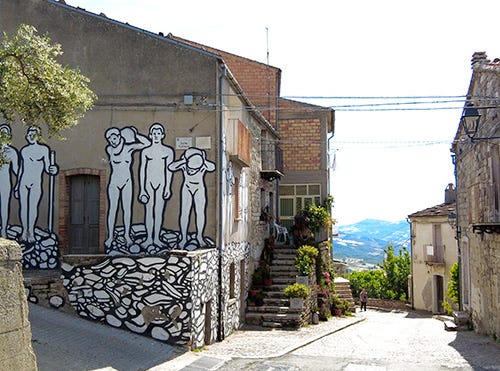
Still, the positive impact of this regeneration could go even further if the effort (and believe me, for a festival driven entirely by the hard work of local residents in a nearly abandoned village with next to no infrastructure, it is a major effort) weren’t concentrated into just three intense days a year.
A year-round cultural presence -through smaller, more frequent events- could offer continuity and reduce the strain on the community.
This year, I got a glimpse of what that future might look like while working with German street artist Case Maclaim, who arrived in Civitacampomarano after the official festival had wrapped up. With the village no longer buzzing with events and logistics, everything slowed down. The focus shifted entirely to one artist, one wall, one mural unfolding in real time.
Without the usual whirlwind of overlapping tasks, the connection between Case and the residents felt deeper. The pride and sense of ownership in the village were still there—just without the stress.
And that change of pace revealed something important: this is what CVTà can become. It’s this kind of slow, grounded presence that I hope will shape the festival’s next chapter.
🎥 Watch the crazy vlog I made at CVTà Street Fest:
Muralism, Then and Now, in Diamante.
Afterwards, I headed even further south for my first collaboration with Gulìa Urbana, an itinerant street art project born in 2012 with a clear mission: to challenge the negative reputation that still clings to Italy’s region of Calabria, one too often reduced to headlines about 'ndrangheta, criminality, poverty, and underdevelopment.
Through public art, Gulìa Urbana has been rewriting that narrative, offering a more complex and creative image of the region. Over the years, the project has hosted both national and international artists, leaving behind murals that speak of identity, resilience, and transformation.
Gulìa Urbana travels from village to village, and the edition I joined took place in Diamante, a town with a long-standing relationship with muralism. Since 1981—well before Italy embraced neo-muralism influenced by the graffiti and street art scenes of New York—Diamante has been known for its collection of public murals.
But the connection between this land and wall-based expression goes even further back. Just outside the town lies the Grotta del Romito, a prehistoric cave where researchers discovered Upper Paleolithic graffiti dating back more than 10,000 years. Sadly, I didn’t manage to visit this time, but it’s a reminder that the instinct to draw on walls is as ancient as the land itself.
That’s what first intrigued me about the project: the chance to witness the juxtaposition of historical and contemporary muralism. In this layered visual landscape, shaped by decades of painting on walls, bold contrasts and unexpected conversations unfold between past and present. And watching those conversations emerge in real time—between styles, techniques, and generations—was truly powerful.
But what struck me the most was the community’s relationship with the murals. Residents didn’t just tolerate public art—they were used to it, proud of it. Murals are part of Diamante’s collective identity, something deeply rooted in the town’s sense of self.
And yet, there was also a fresh curiosity, a renewed sense of welcome extended to the guest artists and to all of us working alongside them. A warmth that blended familiarity with openness, tradition with new energy.
🎥 Watch the crazy vlog I made in Diamante:
Street Art, Community, and Quiet Transformation in Covilhã.
Finally, let’s talk about WOOL – Covilhã Urban Art, Portugal’s first street art festival and one of the most respected in Europe. I’m writing from here now, while the paint is still drying on the latest walls.
WOOL stands out not just for its long history, but for the way it remains deeply rooted in civic engagement and site-specificity.
Covilhã may have accumulated a vast collection of murals over the years, but walking through the city never feels overwhelming. That’s partly due to the shape of the city itself—clinging to the mountainside, unfolding in layers—and partly because the artworks don’t seek to change the face of the town. They blend in. Artists here don’t overwrite the city’s identity—they echo it, poetically and respectfully.
And that’s where the impact lies. At WOOL, every mural grows out of dialogue—with the place, with the people, with the city’s layered memory. The result isn’t just visual transformation—it’s emotional. The kind that reshapes how people feel about where they live and who they are.
From the start, the process is intentional. Before even picking up a brush, the artists spend a full day immersed in Covilhã and its surroundings: exploring the historic center, the natural park, and two former textile factories—one still operating, the other now a contemporary art space. This introduction is essential to transmit the soul of the place, and that makes it easier for artists to truly commit to the territory, to listen before leaving a mark.
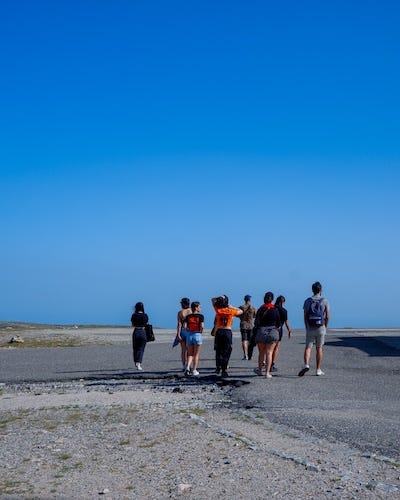
Thanks to this approach, every mural tells a story—about the city’s industrial heritage, its people, its landscapes, its transformation. For visitors, the murals open up unexpected narratives. For residents, they reflect pride, memory, and identity.
I saw all kinds of people stop by the murals in progress: elderly couples, teenagers, factory workers, students, children. Conversations flowed naturally between artists and passersby. The same mix showed up at the mini-concerts, at the street art tours, at the community lunch on the final day, because this is the thing about WOOL: it brings people and places closer together.
In a city long shaped by industry, WOOL has helped give new meaning to the town’s heritage. It doesn’t just celebrate the past—it weaves it into the present, through murals, stories, and moments of shared experience.
🎥 The vlog on WOOL isn’t ready just yet—it’ll be up on YouTube soon. Stay tuned, and don’t forget to subscribe to my channel so you’ll get notified when it drops 😉
Until next month,
Giulia
P.S. If you’re new around here, here’s a more in-depth post on street art festivals—written just ahead of last year’s Grand Tour. Kind of a manifesto, in its own way.
👑 Reader Survey 2025!
Yes, it’s that time of the year again.
If you’ve been reading this newsletter for a while, you know that summer means… reader survey time!
The questions change a bit each year—some stay, some are new—and yes, I’m fully aware this isn’t the most accurate way to run a survey. But then again, BLocal is an ever-evolving editorial project, and this newsletter evolves with it.
So, here’s the link:
Thanks for taking a few minutes to help shape what comes next.
✈️ Travel with me
We’ve decided to postpone the London street art trip, because let’s be honest, it’s much cooler if the trip also includes the chance to get your copy of my London street art book signed by the artists I interviewed for it. 😉
We’re looking at three new dates—let us know which one works best for you:
👌 Handpicked by Yours Truly
Since I’ve already messed with the format of this newsletter, it’s a good moment to bring back that old link-sharing section I haven’t done in ages 😉
Let’s kick things off with the long-time star of this newsletter section: David Sedaris, my favorite writer. There’s a new essay out, and yep, that’s exactly what nudged me to resurrect this dusty old corner of the newsletter.
Another reading tip: “Kentuki” by Samanta Schweblin, which I stumbled upon in a digital-and-tech-themed reading list curated by
. It’s a sharp, unsettling novel about a world where people can remotely inhabit robotic pets inside strangers’ homes. Equal parts creepy and thought-provoking—it really sticks with you.I finally watched the latest season of Black Mirror—my one and only screen-time indulgence in months (I’ve been deep in book mode and craving time away from screens). The first two episodes were my top picks. 😉
Two more books I’ve read lately and really enjoyed: Violeta by Isabel Allende and All My Puny Sorrows by Miriam Toews. One spans a century through the eyes of a fiercely independent woman (Violeta), the other dives deep into the messy, tender bond between two sisters navigating life, art, and mental health (All My Puny Sorrows). Both hit that sweet spot between beautifully written and emotionally wrecking.
WOOL Festival isn’t only about walls. On Thursday evening, we watched this touching documentary about the participative public art projects produced by Madrid-based collective Boa Mistura all around the world:
Let’s wrap things up with one album: still at WOOL festival, there was live music every day — each time by a different mural in progress. I looked one of those bands up (LX30, where “LX” is a common abbreviation for Lisbon) and found their music on Spotify — here’s the link if you’re curious:






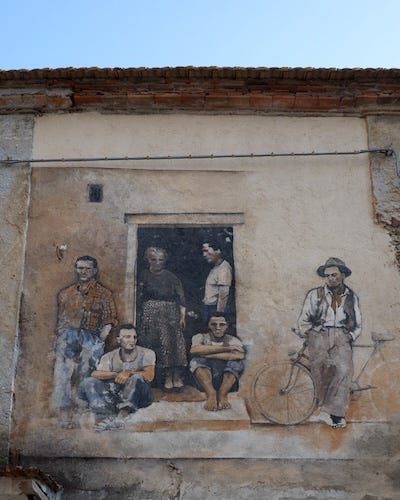
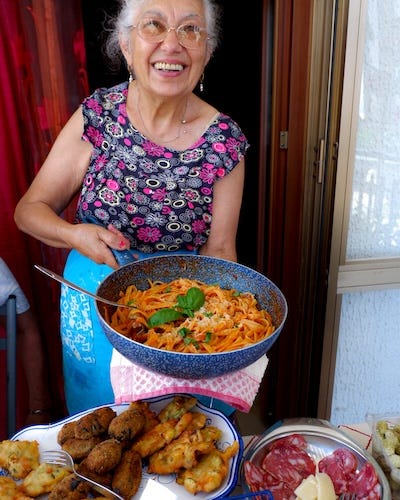
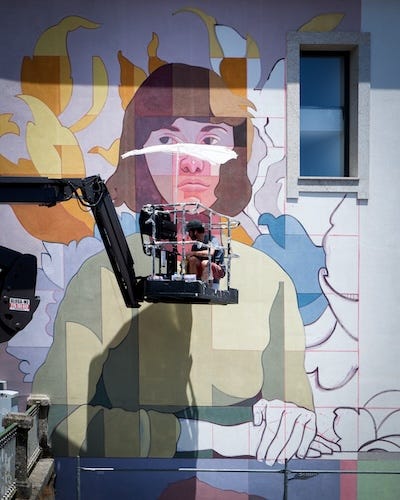
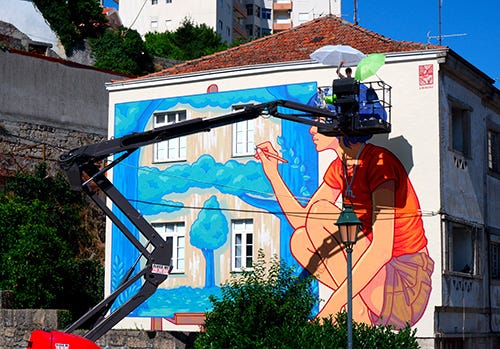

The process at WOOL Covilhã is so inspiring. Artists taking time to explore, understand, and listen before leaving a mark – I wish we could adapt something like this for Marrakech. Since the last street art festival in 2016, the walls aren’t quiet, but there’s no collective sense anymore of what public art can do for a city.